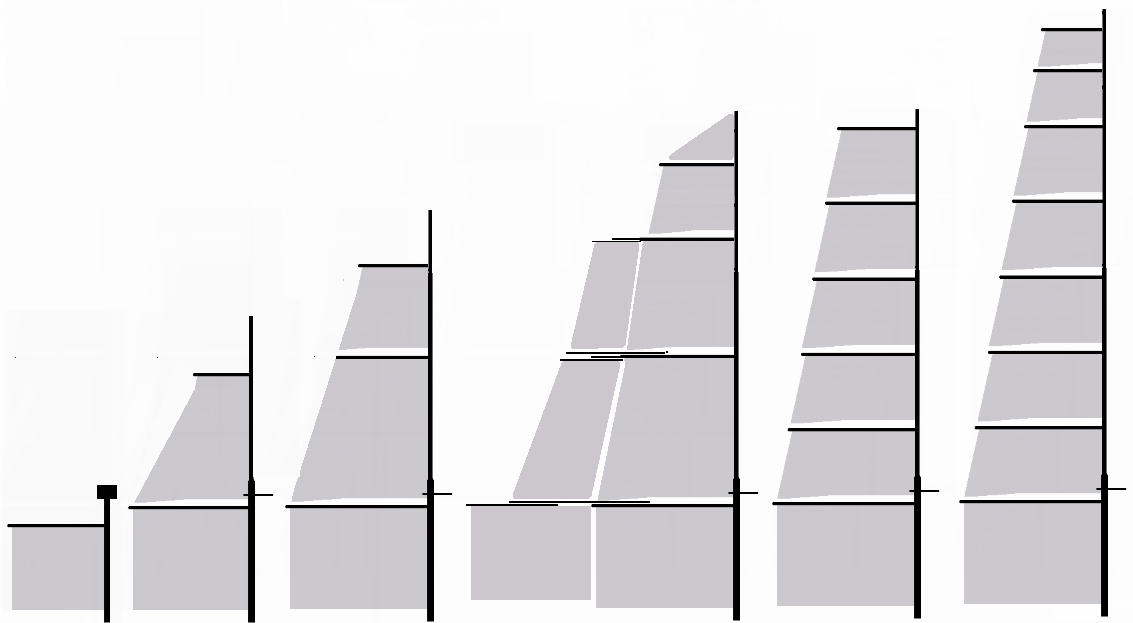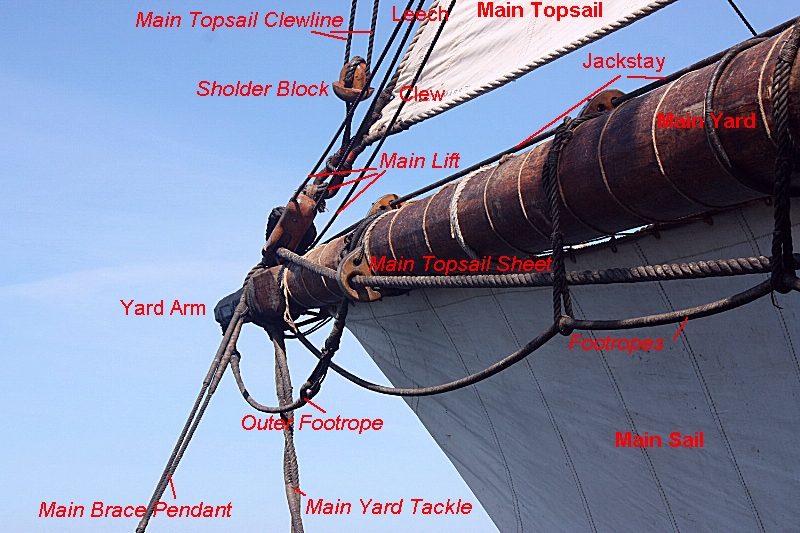
|
The easiest pattern of square sail, used in
Viking ships
and
Hansa cogs.
In Northern Europe and the colonized Americas, this was the predominant rigging through all eras.
The Square rigging is basicly very simple:
a square sail bent to a horizontal yard; one heavy halyard (from "haul-yard") for hoisting the square yard up
and letting it down,
2 braces to swing the yard into the wind, then "optionally" 2 lifts to keep the yard in balance,
an number of bunt- and/or leech-lines for furling,
and on each lower corner of the sail, a clewline,
a tack and a sheet. The sail could be taken in (up) by the buntlines or
by taking the entire yard down on deck,
which is the most common method on the early ships, having one yard only per mast.
|
Later sailing ships "cascaded" up to 8 square sails on top of each other, and every square sail added new lines to the
running rigging.
here, only the port half on the
mast is shown: the rigging "grew" stadily like a tree ...

until 1200, all ships were so small that they only had one sail per mast
then ships became bigger, and the topsail was introduced; the lower sail was then called the course.
around 1400, even topgallant sails were set on top of the topsails. There are often pronounced the "t´gans".
the HMS Royal Sovereign of 1637 is said to be the first ship having royal sails on top of the topgallants
to extend the sail area, additional stunsails were used between 1700 and 1900.
around 1800, topsails were so huge that they were divided into lower and upper topsails
around 1850, even the topgallants were divided into lower and upper topgallants
between 1850 and 1920, the last tall ships could have as much as 8 square sails per mast; yet those "moon sails"
were rare and rarely used.
Due to the setting by the braces,
the strain force of the sail was always to the bow of the ship, thus many shrouds for the mast going abaft,
giving it stability.
Astonishingly, there seem not to have been any stays as on square standing rigging; the
square sail was mostly used for sailing large (being braced square), or more abeam or closed to the wind
(being braced sharp).
A square rigger cannot sail as closed to the wind as a lateen or a fore-and-aft rigger.
A Hoisted or A Fixed Yard
It is either: lower the yard, or furl up the sail to the yard. The running rigging allows for both usages,
whatever the sailmen thought would be more practical and easy to handle.
The Hoisted Yard
Depending on the weight of the yard and the sail, due to their size,
the halyard line to hoist the sail
is the heaviest line of the running rigging.
Heavier yards up to 20m width(!) had a tye rope with a heavy purchase attached to it,
with a double, triple or even quadruple block, going to the mast foot or to the near rail knights
for belaying.
The sail can then be bend easily from the sailors on deck,
or, as a variant, buntlines would be used.
The Fixed Yard
Around 1700, lower yards were so big and heavy (about 2-3 tons!)
that they no longer were hoisted for sail manouvres, but only once in the harbour when the ship was rigged; then
the "geers" were belayed fixed and never touched again until the next rigging repair.
At this time, footropes were introduced to allow sailors to walk out to the yard arm, to work with the sail.
Without this footrope, it was perilous to climb out upon the yard; on bigger ships, the sheets of the next upper sail
could serve as footropes, and were certaily their "prototypes".

A detail from the main yard arm of the
Götheborg III, showing the sheets lead and the foot ropes
This "fixed option" is possible for any kind of yard - You just do not use the halyard and keep the yard up.
But then, the sail must be taken in by other means than lowering the yard onto deck, so the "buntlines"
were essential to do the job. Depending on the size of the sail, many buntlines were used, up to 10,
to drag the canvas up to the yard.
The Problem is then, the canvas still flaggs in the wind ...
In 2009, I had the luck to see it in reality onboard the Swedish replica of the East-Indiaman "Götheborg": the lower yards
were "fixed", all other yards were veered for reefing or taking in sails.
When wind comes from the bow, all square sails are completely useless, the ship would be pushed back
(which was indeed used in seawar manouvres as a tactic!).
|


